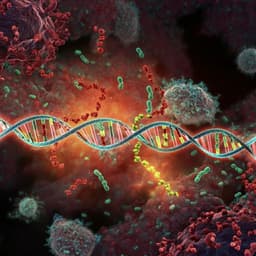
Medicine and Health
Detection of SARS-CoV-2 viral proteins and genomic sequences in human brainstem nuclei
A. Emmi, S. Rizzo, et al.
Explore the intriguing connections between COVID-19 and the nervous system in this study revealing neuroinvasive potential of SARS-CoV-2, conducted by Aron Emmi, Stefania Rizzo, Luisa Barzon, and others. Discover how brainstem inflammation could influence neurodegeneration!
~3 min • Beginner • English
Introduction
The study addresses whether SARS-CoV-2 can infect the central nervous system and what neuropathological alterations in COVID-19 are attributable to direct viral neurotropism versus immune-mediated or systemic effects. Contextually, neurological manifestations are frequent in COVID-19, including acute and long-term symptoms. Prior evidence from autopsy series is mixed: some studies detect viral material in limited brain regions without classic encephalitic changes, whereas others fail to detect virus. Common neuropathology in COVID-19 includes hypoxic-ischemic injury, astrogliosis, microglial activation, and microvascular injury. Experimental models show conflicting neurotropism in human neural cells but brain infection in susceptible mouse models. This study’s purpose is to systematically examine brainstem-focused neuropathology in COVID-19 decedents versus matched pneumonia/respiratory failure controls, test for viral proteins and RNA in CNS tissues, and quantify microglial responses to clarify SARS-CoV-2 neuroinvasion and its potential implications for neurodegeneration.
Literature Review
Large autopsy studies suggest possible SARS-CoV-2 neuroinvasion with sparse infected cells in brainstem, hypothalamus, and cerebellum, generally without encephalitis or virus-specific pathology. Other studies report no detectable viral proteins or RNA in brain tissue. Single-nucleus transcriptomics from severe COVID-19 brains shows innate immune activation, microglial activation, and neurodegeneration-associated signatures without evidence of viral transcripts. Spatial proteomics indicates robust CNS immune activation and blood-brain barrier changes with viral antigens in perivascular ACE2-positive cells. Animal studies with related coronaviruses (SARS-CoV, MERS-CoV) demonstrate brainstem neurotropism, particularly targeting vagal nuclei. Reports on SARS-CoV-2 in human neural cultures/brain organoids are inconsistent, often showing poor neuronal infection but choroid plexus susceptibility. Together, prior literature supports prevalent neuroinflammation and hypoxia-related injury in COVID-19 and inconsistent, limited viral neurotropism, motivating targeted brainstem investigation.
Methodology
Design: Post-mortem case-control study of 24 COVID-19 decedents (Veneto Region, Italy; March 2020–May 2021) and 18 age- and sex-matched controls who died from pneumonia/respiratory failure or related conditions before or without COVID-19.
Inclusion for COVID-19: Positive SARS-CoV-2 RT-PCR on nasopharyngeal swabs and availability of high-quality brain tissue (PMI ≤ 5 days, no maceration, fixation ≤ 3 weeks).
Sampling: Brains immersion-fixed in 4% buffered formalin (PMI mean 3 days; fixation 2–3 weeks). Standardized sampling of cerebral cortex, basal ganglia, hippocampus, cerebellar cortex, deep cerebellar nuclei, choroid plexus, meninges, and extensive cranio-caudal brainstem sections (medulla, pons, midbrain). Olfactory bulbs/tracts and cranial nerves were sampled when available.
Histopathology/IHC: H&E for routine pathology. Immunoperoxidase panels included CD3, CD20, CD68 (lysosomal activity), HLA-DR, TMEM119 (homeostatic microglia), Ki-67 (proliferation), GFAP (astrogliosis), CD61 (platelet microthrombi), and SARS-CoV-2 nucleocapsid (N) and spike (S) proteins. ACE2 and TMPRSS2 expression were assessed. Anti-viral antibodies validated using infected Vero E6 cells and COVID-19 lung tissues; historical tissues served as negatives.
Immunofluorescence/Confocal: Double-label IF for TMEM119/CD68, N or S with β-III tubulin (neuronal marker), N with tyrosine hydroxylase (dopaminergic neurons), ACE2/TMPRSS2; Sudan Black B used to reduce autofluorescence; confocal z-stacks acquired and analyzed with ImageJ.
RT-PCR: Real-time RT-PCR on 20 μm FFPE sections targeting SARS-CoV-2 N region; subgenomic RNA also assayed (not detected, likely due to FFPE RNA degradation). RNAseP served as internal control. Sterile sampling procedures minimized contamination.
Quantification of microgliosis: TMEM119+ microglia were counted (cells/mm²) across six predefined fields of view (FOV) per brainstem level (medulla, pons, midbrain), grouped into anatomical compartments (tegmentum, tectum, pes) per neuroanatomical landmarks (Mai & Paxinos). CD68+ immunoreactive area (A%) quantified in random FOVs as a proxy of lysosomal/phagocytic activity. Microglial nodules and perineuronal microglia were documented. Three blinded evaluators assessed slides; discrepancies resolved by consensus.
Statistics: GraphPad Prism 9. Welch one-way ANOVA with Dunnett’s multiple comparisons for FOVs and compartments; Welch-corrected t-tests for subgroup comparisons; Spearman correlations and linear regression for clinical-pathological associations. Significance: p<0.05.
Key Findings
Cohorts: 24 COVID-19 decedents (mean age 73±13.7 years; 11 female) and 18 controls (mean age 72±12 years; 8 female) with similar comorbid profiles and causes of death (pneumonia/respiratory failure predominated).
General neuropathology: Both cohorts showed diffuse hypoxic/ischemic injury and astrogliosis, often pronounced in brainstem. Alzheimer disease and cerebral amyloid angiopathy were present in a subset of both groups. One COVID-19 subject had Parkinson’s disease pathology.
Microthrombi: Platelet-enriched microthrombi (CD61+) in small CNS parenchymal vessels were found in 9/24 COVID-19 patients (not in controls), frequently in pons, deep cerebellar nuclei, and cortex; often accompanied by pulmonary thromboses. Some had CNS-only microthrombi. Controls had no CNS or systemic microthromboses.
Viral RNA and proteins: Real-time RT-PCR detected SARS-CoV-2 RNA in 10/24 COVID-19 cases (Ct 33–38; RNAseP Ct 27–34). Subgenomic RNA was not detected (likely FFPE-related). Viral proteins (S and/or N) were detected in 7/24; 5/24 had immunoreactive neurons localized within brainstem nuclei (solitary tract nucleus, dorsal motor nucleus of the vagus, nucleus ambiguus) and substantia nigra. Endothelial cell immunoreactivity to viral proteins was observed in select small vessels (hippocampus, cortex, deep cerebellar nuclei, midbrain), sometimes co-localizing with microthrombi, perivascular leakage, or hemorrhage. In several ischemic/thrombotic cases, viral proteins/RNA were not detected.
Neuronal tropism: Double-label IF showed SARS-CoV-2 N protein in β-III tubulin+ neurons/neurites in medulla and midbrain, including both tyrosine hydroxylase-positive (dopaminergic) and -negative neurons in substantia nigra.
Microglial activation and nodules: COVID-19 brains exhibited widespread activated microglia (TMEM119+ with thorny/amoeboid morphology) and increased lysosomal activity (CD68). CD68+ immunoreactive area was higher in medulla and midbrain versus controls (Welch ANOVA, p<0.0001 for both), but not in pons. Microglial nodules with perineuronal TMEM119+/CD68+/HLA-DR+ cells suggestive of neuronophagia were present in 18/24 COVID-19 subjects across substantia nigra (N=14), dorsal motor nucleus of the vagus (N=12), medullary reticular formation (N=9), area postrema (N=6), and basal ganglia (N=5); none in controls. Little-to-no Ki-67 signal suggested activation/migration without proliferation.
Perivascular macrophages and cytokines: Perivascular macrophages expressed CD206 (M2 phenotype) in both groups, with higher densities in COVID-19 medulla and midbrain. Microglia did not express CD86/CD206 surface markers but were immunoreactive for IL-1β, IL-6, and TNF-α (not IL-4), indicating a pro-inflammatory phenotype.
Topography of microgliosis: Medulla showed higher microglial densities in tegmentum versus pes (p<0.001). Midbrain showed highest densities in tegmentum/substantia nigra versus tectum/pes (p<0.0001), indicating an anatomically segregated pattern. Compared to controls, COVID-19 had significantly higher microglial densities in medulla and across midbrain compartments; pons showed no significant group difference.
Correlations: Hospitalization time correlated with medullary microglial density (r=0.44; p=0.044), but not with pons/midbrain. Medullary microglial density correlated with brainstem hypoxic/ischemic damage (r=0.59; p=0.004). No differences in microgliosis by intensive oxygen therapy or Alzheimer pathology status.
Association with viral antigens: Within COVID-19, cases positive for viral RNA/antigen (RT-PCR+/IHC+) had higher microglial densities specifically in medullary tegmentum (p=0.017) and midbrain tegmentum (p=0.0074), though overall regional microgliosis did not differ from negatives. This suggests local microglial recruitment to sites with detectable viral material.
Discussion
Findings support that SARS-CoV-2 can be present within specific CNS regions, notably vagal nuclei in the medulla and the substantia nigra, and within vascular endothelium, in a subset of severe COVID-19 cases. Despite this neurotropism, there was no direct evidence of cytopathic neuronal injury in infected cells in the acute fatal phase. COVID-19 brains showed a distinct, anatomically segregated brainstem microgliosis (medullary tegmentum and ventral midbrain/substantia nigra) compared to pneumonia controls, with microglial nodules and evidence of neuronophagia, and increased lysosomal activity. Local microglial densities were higher at sites with detectable viral antigen/RNA, indicating a topographically specific immune response, but overall microgliosis correlated more strongly with hypoxic/ischemic injury and likely systemic inflammation, underscoring multifactorial drivers of CNS pathology in COVID-19.
Detection of viral antigens in dopaminergic and non-dopaminergic neurons of the substantia nigra and in vagal nuclei aligns partially with known coronavirus neurotropism to brainstem autonomic centers and raises hypotheses about routes of CNS entry (possible hematogenous/perivascular involvement, in addition to olfactory or cranial nerve routes). Given known interactions between viral infections, alpha-synuclein biology, and neuroinflammation, the observations may have implications for susceptibility to neurodegeneration, including Parkinson’s disease, but direct causal links were not established in this acute post-mortem cohort.
Conclusion
This study documents, in a subset of fatal COVID-19 cases, the presence of SARS-CoV-2 RNA and proteins in anatomically defined CNS regions (medullary vagal nuclei and substantia nigra) and demonstrates a COVID-19-associated, anatomically segregated pattern of brainstem microgliosis that differs from pneumonia/respiratory failure controls. While these findings support neuroinvasive potential, overt virus-specific neuronal damage was not observed in the acute phase, and brainstem pathology appears strongly influenced by hypoxia/ischemia and systemic inflammation. The results highlight the need for longitudinal and post-acute investigations, including in long COVID, to determine persistence of CNS viral material, functional consequences, and whether neuroinflammation/neurotropism contribute to neurodegenerative processes, particularly Parkinson’s disease.
Future research directions: prospective clinico-pathological correlation in survivors; sensitive assays for persistent/low-level CNS infection; mechanistic studies of vascular and neuronal entry routes; characterization of microglial phenotypes over time; evaluation across SARS-CoV-2 variants and broader brain regions.
Limitations
- Post-mortem, acute-phase cohort limits inference on temporal evolution and functional consequences; no longitudinal neurological follow-up was available, restricting clinico-pathological correlations.
- Control group comprised patients with pneumonia/respiratory failure rather than healthy controls; retrospective selection may introduce bias, and clinical records (e.g., oxygen therapy) were incomplete for some.
- Sampling emphasized brainstem; involvement of other regions (cerebral/cerebellar cortices, basal ganglia) may be undercharacterized.
- All cases were from the early pandemic; findings may not generalize to later variants.
- RT-PCR on FFPE may detect viral RNA in intravascular compartments and is susceptible to RNA degradation; subgenomic RNA was not detected, likely due to FFPE preservation limits. Despite rigorous sterile technique, contamination cannot be entirely excluded.
- Detection of viral proteins/RNA occurred in a subset of cases; patients undergoing neuropathology often had severe disease and comorbidities, limiting generalizability.
- Absence of functional assays and lack of direct evidence of virus-induced cytopathic neuronal changes constrain interpretation of neurotropism’s clinical significance.
Related Publications
Explore these studies to deepen your understanding of the subject.







